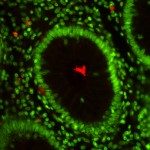Link to Pubmed [PMID] – 7957095
EMBO J. 1994 Nov;13(22):5293-302
Shigella species are enteropathogens that invade epithelial cells of the human colon. Entry into epithelial cells is triggered by the IpaB, IpaC and IpaD proteins which are translocated into the medium through the specific Mxi-Spa machinery. In vitro, Shigella cells secrete only a small fraction of the Ipa proteins, the majority of which remains in the cytoplasm. We show here that upon interaction with cultured epithelial cells or in the presence of fetal bovine serum, S.flexneri release pre-synthesized Ipa molecules from the cytoplasm into the environment. Evidence is presented that IpaB and IpaD are essential for both blocking secretion through the Mxi-Spa translocon in the absence of a secretion-inducing signal and controlling secretion of the Ipa proteins in the presence of a signal. Subcellular localization and analysis of the molecular interactions of the Ipa proteins indicate that IpaB and IpaD associate transiently in the bacterial envelope. We propose that IpaB and IpaD, by interacting in the secretion apparatus, modulate secretion.
